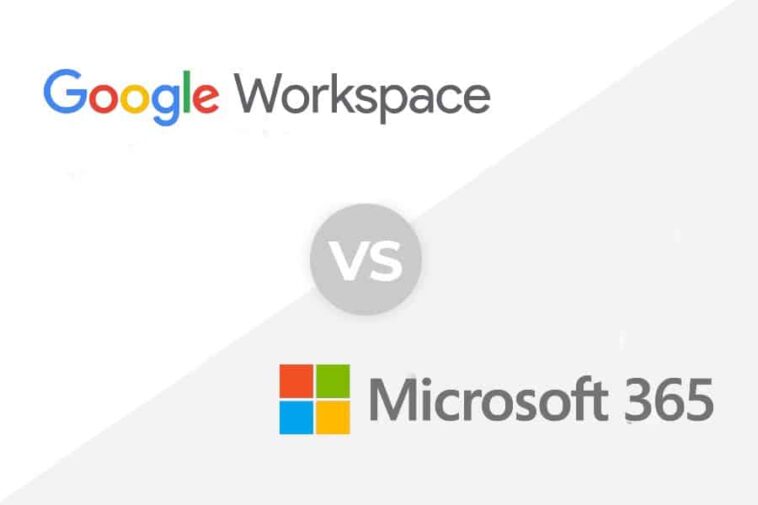Google Workspace VS Microsoft 365: A Comprehensive Comparison
In today’s digital age, office productivity software is essential for businesses and individuals alike. Two of the biggest players in this arena are Google Workspace and Microsoft 365. Both offer a suite of tools designed to enhance productivity and collaboration, but they have their differences. In this article, we’ll compare Google Workspace and Microsoft 365 in various aspects to help you choose the one that best fits your needs.
Google Workspace VS Microsoft 365
1. Office Applications:
Google Workspace: Google Workspace offers a suite of cloud-based office applications, including Google Docs (word processing), Google Sheets (spreadsheets), and Google Slides (presentation software). These applications are known for their simplicity, real-time collaboration features, and ease of use. Users can access their documents from any device with an internet connection.
Microsoft 365: Microsoft 365, on the other hand, includes the well-known Microsoft Office suite, which consists of Microsoft Word, Excel, and PowerPoint. These applications are feature-rich and widely used in business environments. They offer powerful functionality and the ability to work offline when needed.
2. Collaboration and Sharing:
Google Workspace: Google Workspace excels in real-time collaboration. Multiple users can work on a document simultaneously, and changes are saved automatically. It offers easy sharing options, allowing users to set specific permissions and access controls. Google Drive provides ample cloud storage for your documents.
Microsoft 365: Microsoft 365 offers collaboration features through OneDrive and SharePoint. While it supports real-time co-authoring in Microsoft Word and Excel, it’s often seen as not as seamless as Google’s collaboration features. Nevertheless, it provides robust tools for document sharing and storage.
3. Email and Communication:
Google Workspace: Google Workspace provides Gmail for email communication, which is known for its excellent spam protection and search functionality. It also offers Google Meet for video conferencing and Google Chat for instant messaging and team communication.
Microsoft 365: Microsoft 365 includes Outlook for email, a widely used and robust email client. It also offers Microsoft Teams for video conferencing, chat, and team collaboration. Many businesses prefer Teams for its integration with other Microsoft 365 apps.
4. Pricing:
Google Workspace: Google offers a range of pricing plans for Workspace, starting with the Basic plan, which is suitable for small businesses and costs per user per month. The Business and Enterprise plans offer more features, such as enhanced security and compliance tools, at higher price points.
Microsoft 365: Microsoft offers multiple plans for 365, including Microsoft 365 Business Basic, Microsoft 365 Apps, and Microsoft 365 Business Standard, among others. The pricing varies depending on the number of users and features required.
5. Storage:
Google Workspace: Google Workspace includes a certain amount of cloud storage based on the plan you choose. The Basic plan offers 30GB of storage per user, while Business and Enterprise plans provide 2TB or more per user.
Microsoft 365: Microsoft 365 offers 1TB of OneDrive cloud storage per user for most plans. Additional storage may be available with higher-tier plans or as an add-on.
6. Integration:
Google Workspace: Google Workspace seamlessly integrates with various third-party apps through the Google Workspace Marketplace. While it may not have the extensive integration options of Microsoft 365, it’s still quite versatile.
Microsoft 365: Microsoft 365 offers a vast ecosystem of integrated apps and services, thanks to its extensive history in the business software market. It integrates well with other Microsoft products, such as Dynamics 365 and Power BI.
Google Workspace VS Microsoft
7. Security:
Google Workspace: Google Workspace offers robust security features, including two-factor authentication, data loss prevention, and advanced threat protection. It’s known for its strong focus on data security.
Microsoft 365: Microsoft 365 provides enterprise-level security with features like Azure Active Directory, Advanced Threat Protection, and Information Protection. It’s often the choice for businesses with strict security and compliance requirements.
8. Support:
Google Workspace: Google offers support through its Help Center and community forums. Premium support is available for an additional fee.
Microsoft 365: Microsoft provides comprehensive support options, including phone support, email support, and online resources. Higher-tier plans come with enhanced support.
Conclusion:
The choice between Google Workspace and Microsoft 365 ultimately depends on your specific needs and preferences. Google Workspace is known for its simplicity, real-time collaboration, and cloud-first approach, making it a great choice for small to medium-sized businesses. On the other hand, Microsoft 365 offers powerful, feature-rich applications, strong integration options, and robust security, making it a top choice for larger enterprises and businesses with complex requirements.
In either case, both Google Workspace and Microsoft 365 are excellent office productivity suites that can significantly enhance your organization’s efficiency and collaboration capabilities. Consider your priorities, budget, and the unique requirements of your business when making your decision.




Comments
0 comments